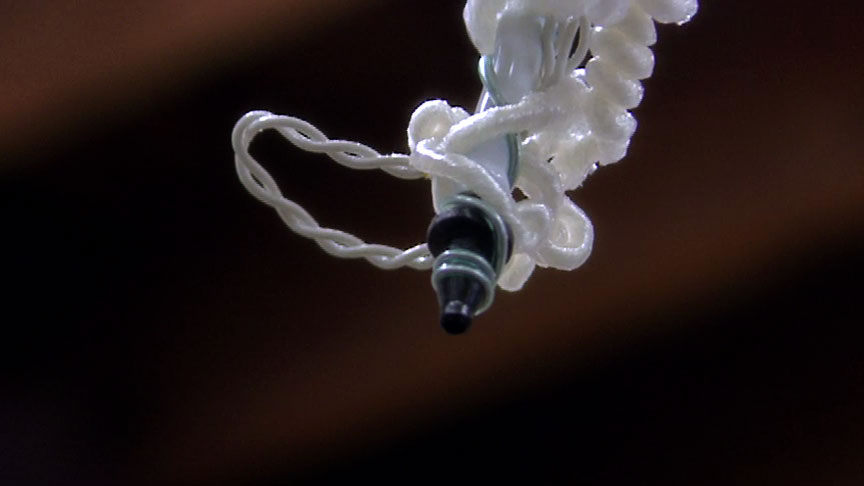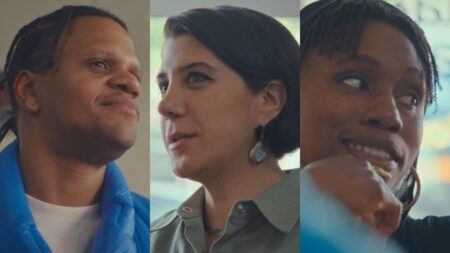Interview
“Drip” and “Emoter”

Tim Hawkinson works on Drip (2002) in his Los Angeles studio, 2002. Production still from the Art in the Twenty-First Century Season 2 episode, Time. © Art21, Inc. 2003.
Artist Tim Hawkinson discusses his 2002 installation Drip, his 2000 installation Emoter, and the similarities between the two.
ART21: What is the inspiration behind Drip? What led you to creating that piece?
HAWKINSON: Sometimes we do get rain in L.A. A lot of us aren’t really prepared. The studio has areas in the ceiling that sometimes will leak. And it was really great, just walking into the studio one time, and there were buckets around, all catching the drips. It just had a great sound in the space. So, I was interested in using dripping water, some way. I didn’t want just random drips; I wanted something that really felt like something you could dance to, something choreographed-sounding. So, I ended up making this almost computerized abacus. It was a machine that was sort of a drumming machine. It generated different rhythmic patterns. It was hooked up to solenoid valves, and each time the valve was triggered, it would allow a drip to drop into a bucket, creating a resonant plop. Each bucket had its totally different resonance, so it was a kind of sound piece.
I was interested in making something that would create this really rhythmic sound pattern. I downloaded a drumming machine on my computer, and I was trying to figure out how I could get something that would generate these random patterns but would still have this choreographed sound to it. And so, it’s taking random patterns off of the gears, and then those are being chopped up. This turns around, and every time it hits this metallic strip, it closes this circuit. One of these little wires sending a signal from the gear will get triggered through that. And this is just a way of lining all the signals up, so that they all occur at the same time within. I mean, it’s spinning really rapidly, so it’s all within a split second. Otherwise, it sounds really chaotic, and this way it’s, um, more synchronized.

Tim Hawkinson works on Drip (2002) in his Los Angeles studio, 2002. Production still from the Art in the Twenty-First Century Season 2 episode, Time. © Art21, Inc. 2003.
There are so many variables. This one is really quiet because it’s so much closer to the bucket. And when it’s installed, I imagine these will all pretty much be at the same height. And it’ll probably be just above eye level because I like being able to walk underneath them and the precariousness of maybe getting dripped on once in a while.
I guess, formally, when I first pictured it, I was playing around with this wadded and spun plastic, and I just kind of saw this creature that was almost like something that grew in the ocean or in an antigravity kind of environment, where it was growing freeform. And so, it’s like this thing that was dredged up out of the water and hung up to dry. I know it’s sort of a crazy-looking thing, and I guess to somebody that’s not involved in the process, they would be more aware of the humor in it. But beyond, I guess, for me it’s more about different rhythms. I mean there’s this visual rhythm that is carried throughout the piece—the twists and turns of the material and the pattern created by the sound of the dripping water.
ART21: How did you discover this material?
HAWKINSON: The plastic—well, I think it was originally just, like, some Reynolds Wrap that I had twisted up, and I liked the way it took its form. It was just this freeform, really random pattern that occurred. And so, I was interested in exploring that or trying it out on different scales. And I think it’s important to use with the different thicknesses of plastic, different heaviness, to get these different patterns. I guess this form kind of grew out as a three-dimensional expansion out of some drawings that I was working on—just, actually, using a drill to spin a pencil or a pen around. And I made a device that would open and close the diameter of the spin, the arc of the spin while this is in motion. So, I was able to create larger and smaller kind of scrawls. There were these drawings that were almost reminiscent of intestines or worms.

Tim Hawkinson works on Drip (2002) in his Los Angeles studio, 2002. Production still from the Art in the Twenty-First Century Season 2 episode, Time. © Art21, Inc. 2003.
ART21: Can you talk a little bit about Emoter, another piece that uses random signals?
HAWKINSON: It’s something that emotes, and it’s motorized. Emoter falls into the category of body depiction—references to the body—like the bathtub-generated piece and balloon self-portraits that I’ve done. But it’s much more about mechanics and probably closer to a piece I did that synthesized voice using really primitive methods. Emoter uses the expressions of the face that are so cued into reading the face. I took a picture of myself and cut the features up into little pieces, like a puzzle, and rearranged the features. And each time I did it, I created a different emotion, and that’s just something I read into it. Anybody looking at it would read into this, would reinterpret it, as I think we all pretty much interpret the same basic emotions—frowning, smiling—but I was interested in seeing how much inflection and emotion I could get out of the face using a random input of signals.
I was interested in using random signals, in this case generated by a television screen. And the screen had lights instead of switches. So, if there was a dark area on the screen, it would turn the signal on, and a light signal would shut it off. Just on and off, nineteen different on and off signals. There are nineteen wires for the nineteen switches and the nineteen motors in the face, all connected with Velcro. The initial idea was just taking random input and converting it into something. Originally I was thinking of making a three-dimensional realization, this kind of instant bas-relief sculpture. That was sort of interesting but still too abstract. Then I started thinking about imagery and the face and how any kind of input into the face—no matter how irrational or un-patterned—would still create something we can decipher, look at, and read and get some sort of message from. I’m using my face, but I don’t really consider it a psychological self-portrait or anything like that. I can’t make most of these faces myself.

Tim Hawkinson demonstrates Emoter (2000) at the Whitney Museum of American Art, New York, 2002. Production still from the Art in the Twenty-First Century Season 2 episode, Time. © Art21, Inc. 2003.
I took the photograph with this piece in mind. I use my image or my body in a lot of the work as my jumping-off point, but usually the end result is so abstracted that I don’t really feel so identified with it any longer. Using images of myself or impressions of my body is just a way of using a universal kind of stand-in for anybody that I hope other people can identify with. It’s not about my identity; it’s about our identity and our experiences within our bodies, and our bodies’ relationship to the external world.
A lot of the body pieces that I do are concerned with measuring the body or presenting the body in this extremely specific way. So, they’re really accurate, in one way, and almost hyperrealist. But at the same time, that process abstracts them and brings them away from a normal body so much that they no longer look like the original form.

Tim Hawkinson. Emoter, detail, 2000. Mixed media: image, 49 × 36 × 4 inches; ladder, 27 × 24 × 19 inches; cable, 174 feet. Private collection. Courtesy Ace Gallery, Los Angeles.
ART21: Are there similarities you see between Drip and Emoter? How do the two pieces fit into your body of work?
HAWKINSON: There are certain recurring interests in my work and ways of looking at things, maybe having to do with the way I get ideas and the way ideas are formed—really obvious categories. The first thing that I think of is the human form and using my own body as the reference point—ways of depicting and referring to that, and “re-looking” at that through different eyes. There are also pieces that deal with time and the way we process time and are aware of it. There are mechanical interests and kinetic work, a fascination with moving parts—just the magic of seeing this kind of animation and making it happen. But then, I also like to keep a dialogue going with drawing and some painting and these weird, quirky drawings that I kind of fall upon occasionally. A lot of times different interests overlap. For some of the drawings, I’ll make a mechanical device that will help in making the drawing, and stuff like that.
Each piece and each direction have an approach. They’re not really rules. They’re more sorts of parameters or a process—a way of filtering out other things that aren’t really concerned with the idea I’m working with—and, I guess, by a strict adherence to the process, it creates a certain distortion. But it’s also what art is—the distillation of the idea. What I’m shooting for is just to stick with whatever that idea is and play it out till it’s totally this pure form.
This interview was originally published on PBS.org in September 2003 and was republished on Art21.org in November 2011.



